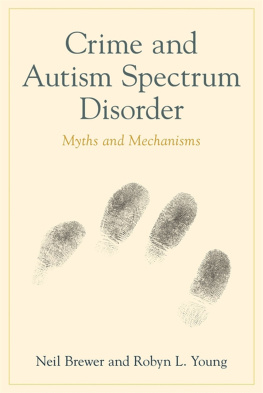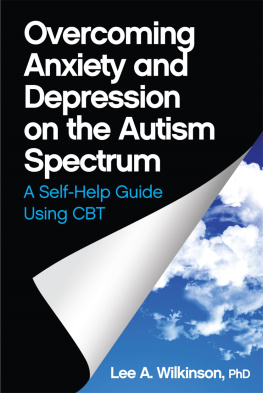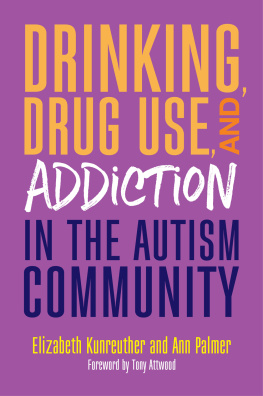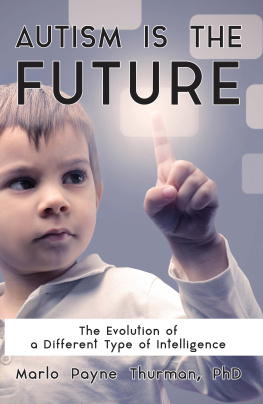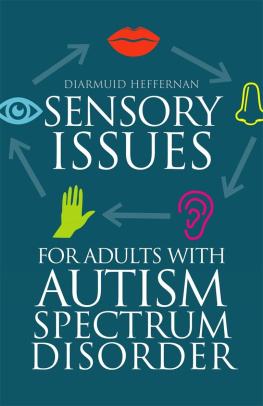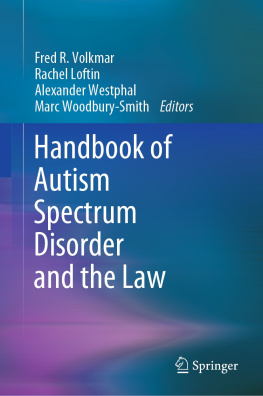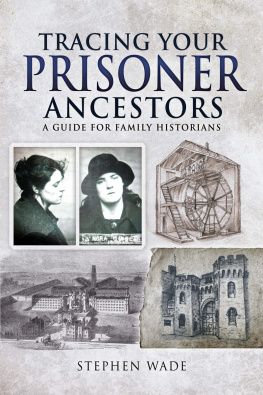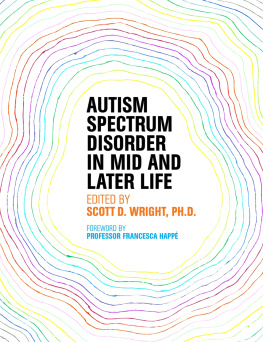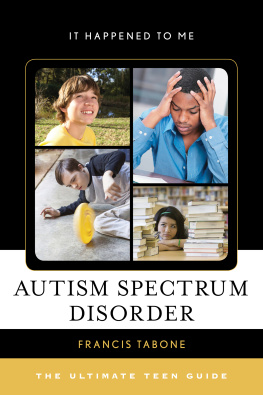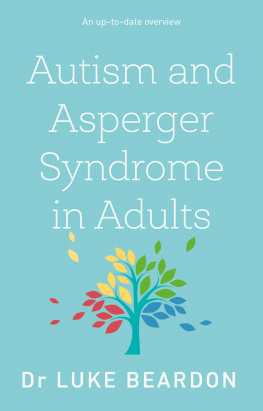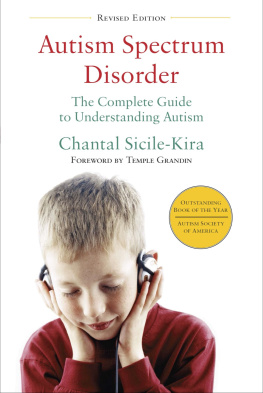
Crime and Autism Spectrum Disorder
Myths and Mechanisms
Neil Brewer and Robyn L. Young

Jessica Kingsley Publishers
London and Philadelphia
reproduced with permission from Benjamin Wallace/New York Magazine.
First published in 2015
by Jessica Kingsley Publishers
73 Collier Street
London N1 9BE, UK
and
400 Market Street, Suite 400
Philadelphia, PA 19106, USA
www.jkp.com
Copyright Neil Brewer and Robyn L. Young 2015
Front cover image source: iStockphoto. The cover image is for illustrative purposes only.
All rights reserved. No part of this publication may be reproduced in any material form (including photocopying or storing it in any medium by electronic means and whether or not transiently or incidentally to some other use of this publication) without the written permission of the copyright owner except in accordance with the provisions of the Copyright, Designs and Patents Act 1988 or under the terms of a licence issued by the Copyright Licensing Agency Ltd, Saffron House, 610 Kirby Street, London EC1N 8TS. Applications for the copyright owners written permission to reproduce any part of this publication should be addressed to the publisher.
Warning: The doing of an unauthorised act in relation to a copyright work may result in both a civil claim for damages and criminal prosecution.
Library of Congress Cataloging in Publication Data
Brewer, Neil.
Crime and autism spectrum disorder : myths and mechanisms / Neil Brewer and Robyn L. Young.
pages cm
Includes bibliographical references and index.
ISBN 978-1-84905-404-1 (alk. paper)
1. People with mental disabilities and crime. 2. Autism spectrum disorders. I. Young, Robyn (Robyn
Louise) II. Title.
HV6133.B74 2015
364.38--dc23
2014048579
British Library Cataloguing in Publication Data
A CIP catalogue record for this book is available from the British Library
ISBN 978 1 84905 404 1
eISBN 978 0 85700 773 5

Contents

Acknowledgments
We thank Clare Holmes and Darren Hedley for assistance with literature searching and notation, and Nicole McCallum for referencing assistance.
Chapter 1

SOME BAD GUYS
Every generation has its defining psychiatric malady, confidently diagnosed from afar by armchair non-psychiatrists. In the fifties, all those gray-suited organization men were married to frigid women. Until a few years ago, the country of self-obsessed boomers and reality-TV fame-seekers and vain politicians and bubble-riding Ponzi schemers made narcissistic personality disorderdiagnosis code 301.81 in the American Psychiatric Associations Diagnostic and Statistical Manual of Mental Disorders, fourth editionthe craziness of the moment. And who among us has not proudly copped to our own OCD or ADD, deemed a mercurial sibling seriously bipolar, written off an erratic ex as obviously borderline, or nodded as a laid-off friend pronounced his former boss a textbook sociopath? Lately, a new kind of head case stalks the landstaring past us, blurting gaucheries, droning on about the technical minutiae of his boring hobby. And we are ready with our DSM codes: 299.00 (autistic disorder) and 299.80 (Aspergers disorder). (Wallace 2012).
Wallaces piece highlights that almost any high-profile person who might have displayed some form of social distinctiveness or awkwardness may have been loosely labelled as being on the spectrum . Identities listed by Wallace and others include Mitt Romney, Barack Obama, Bill Gates, Mark Zuckerberg, Warren Buffett, Dennis Rodman, Jim Carrey, Daryl Hannah, Slash, Billy Joel, J. K. Rowling, Adam Carolla, Kanye West, Dan Harmon, Clay Marzo, Gary Numan, Abraham Lincoln, Albert Einstein, Alexander Graham Bell, Bla Bartk, Benjamin Franklin, Bobby Fischer, Carl Jung, Emily Dickinson, George Bernard Shaw, George Washington, Marilyn Monroe, Henry Ford, Isaac Newton, Jane Austen, Ludwig van Beethoven, Mark Twain, Michelangelo, Thomas Edison, Thomas Jefferson, Vincent van Gogh, Virginia Woolf, Wolfgang Amadeus Mozart, Alfred Hitchcock, Andy Warhol, Charles Schulz, Howard Hughes, Jim Henson, John Denver, Al Gore, Bob Dylan, Charles Dickinson, David Helfgott, James Taylor, John Motson, Oliver Sacks, Robin Williams, Napoleon Bonaparte, Teddy Roosevelt, Leonardo da Vinci, Elvis Presley, Tom Hanks, Shakespeare, Goethe and even Hans Asperger. The suggestion that any or all of the above artists, inventors, musicians, politicians, authors, actors and other well-known individuals may be on the spectrum has occurred despite the fact that few of these people have been formally diagnosed; indeed, some have even been labelled posthumously. Clearly the suggestion that these individuals may be on the spectrum has sometimes been made in jest. Nevertheless, the tendency to apply the label in the absence of any clinical diagnosis indicates a preparedness to connect the label autism spectrum disorder (ASD) with displays of any behaviour that are out of the ordinary.
The application of the on the spectrum tag has not, however, been restricted to off-the-cuff labelling of high-profile achievers. It has also been applied to individuals such as Nicky Reilly, Robert Napper, William Cottrell, Jeffrey Dahmer, Ted Kaczynski, Adam Lanza, Martin Bryant and Anders Breivik all men who have committed brutal crimes such as rape, arson and mass murder and computer hackers such as: Adrian Lamo and Gary McKinnon. It is of course possible that this diverse array of individuals shares a single pathology that explains their criminal behaviour. But the tendency to invoke the on the spectrum tag when discussing all manner of unusual behaviours highlights just how common the use of this diagnostic term has become and the diversity of the individuals to whom it has been applied.
When peoples behaviour significantly violates social norms it is not uncommon for observers to seek a label that purports to provide some sort of psychological explanation for their behaviour. Often these labels emerge not on the basis of any formal diagnostic procedure but rather from suggestions made by onlookers. The following three case studies describe the behaviour of men for whom the ASD label was applied by onlookers, media or professionals, apparently in an attempt to provide a meaningful and unitary explanation for their extreme criminal behaviour. For each of these cases we (a) outline the criminal event, (b) indicate how the application of the ASD label arose (i.e., the diagnosis) and (c) highlight the involvement of other intertwined and likely causal factors.
Some Major Crimes Linked to ASD
The Crimes of Martin Bryant, Gary McKinnon and Adam Lanza
The Crimes
Martin Bryant was responsible for the largest mass killing by a single individual in Australia. In a shooting spree in 1996, he shot and killed 35 holidaymakers and diners, and injured 21 others, at Port Arthur in the Australian state of Tasmania. He is currently serving 35 life sentences plus 1035 years without parole in the psychiatric wing of a prison hospital. Gary McKinnon, a UK citizen and resident, was arrested in 2002 for hacking into the computer systems of the US Government and was indicted on multiple charges. After ten years of legal wrangling, including attempts to extradite him to the US for trial, the Department of Public Prosecutions has elected not to bring criminal charges against him. In 2012 Adam Lanza shot and killed his mother, 20 students and 6 teachers at Sandy Hook Elementary School in Connecticut, USA, before shooting himself.
Next page
